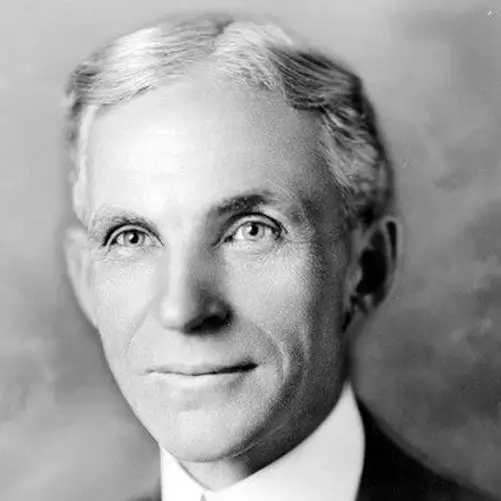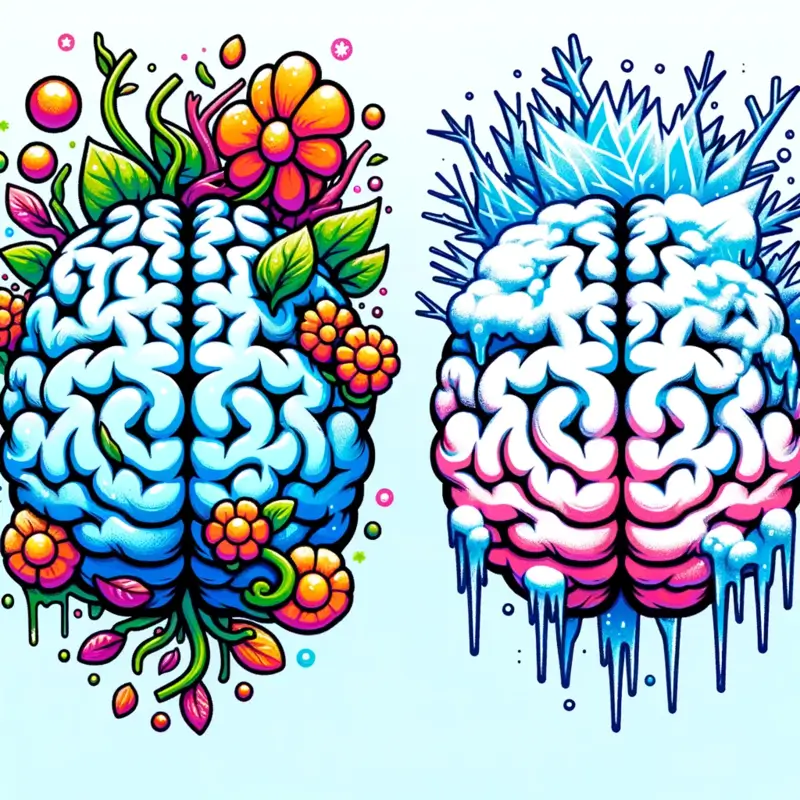The mindset is the invisible force that guides our reactions, decisions, and, ultimately, our destiny. Within this broad spectrum, two distinct types of mindsets emerge as critical influencers: the growth and the fixed mindsets.
Understanding these mindsets isn’t just an academic exercise; it’s a practical tool for improving our lives. Recognizing where we stand and how we approach various situations can help us cultivate a mindset that sees potential and seeks to maximize it.
"Failure is simply the opportunity to begin again, this time more intelligently."
 Henry Ford
Henry Ford Growth Mindset vs Fixed Mindset Examples In Real Life
Let’s describe the impact of both fixed vs growth mindset examples in the real-word. We’ll see how the two mindsets manifest daily and influence our responses and decisions.
But first, let’s take a look on what these mindsets are about:
- Fixed Mindset: It assumes that our character, intelligence, and creative ability are static givens that we can’t change meaningfully.
- Growth Mindset: A growth mindset prospers on the challenge and sees failures not as evidence of unintelligence but as growth opportunities and improving existing abilities.
Great, let’s proceed with the examples
Responding to Criticism at Work
- Fixed Mindset: Viewing negative feedback as a personal attack, leading to defensiveness or discouragement.
- Growth Mindset: Seeing feedback as an opportunity to improve and asking questions to deepen understanding.
Facing a New Challenge
- Fixed Mindset: Avoiding new challenges due to fear of failure or believing one doesn’t have the innate ability to succeed.
- Growth Mindset: Embracing the challenge as a chance to learn and grow, regardless of the immediate outcome.
Dealing with Failure in a Project
- Fixed Mindset: Giving up after failing, labeling oneself incapable or incompetent.
- Growth Mindset: Analyzing what went wrong, learning from the experience, and preparing to try again with this new knowledge.
Learning a New Skill
- Fixed Mindset: Quickly feeling frustrated and giving up, believing it’s not for me if the skill doesn’t come naturally.
- Growth Mindset: Persistently practicing, valuing progress over perfection, and enjoying the learning journey.
Viewing Others’ Success
- Fixed Mindset: Feeling intimidated or jealous of others’ successes, viewing it as a reflection of one’s inadequacies.
- Growth Mindset: Being inspired by others’ success, seeing it as a learning opportunity and a source of motivation.
Handling Change in Personal Life or Work
- Fixed Mindset: Resisting change due to fear of the unknown or believing one can’t adapt to new circumstances.
- Growth Mindset: Embracing change as an opportunity for growth and development, adapting flexibly to new situations.

Growth Mindset vs Fixed Mindset in Self-Improvement
Let’s see how fixed and growth mindsets influence our perception of self-identity and approach to self-improvement. Our mindset can significantly impact how we view ourselves and our potential for personal growth.
Impact on Self-Identity
- Fixed Mindset: People with a fixed mindset often have a static view of their identity. They may believe that their personality, intelligence, and talents are unchangeable. This view can lead to a reluctance to leave their comfort zone.
- Growth Mindset: Those with a growth mindset see their identity as dynamic and evolving. They believe they can develop and enhance their qualities through effort and experience, leading to a more flexible and adaptive sense of self.
Approaches to Self-Improvement
- Fixed Mindset Approach: People with a fixed mindset might avoid situations where they have to learn new skills or change their personality, fearing that failure would reflect poorly on their inherent abilities.
- Growth Mindset Approach: Those with a growth mindset are more likely to seek self-improvement opportunities. They view challenges and failures as chances to learn and grow, not as reflections of their worth.
Personal Goals
- Fixed Mindset: Avoid setting ambitious personal goals because of fear of not being naturally skilled enough to achieve them.
- Growth Mindset: Setting challenging personal goals and enjoying the process of working towards them, regardless of immediate success.
Adapting to Feedback
- Fixed Mindset: Dismissing feedback on personal habits or behaviors as irrelevant, believing one’s traits are set.
- Growth Mindset: Valuing feedback as a tool for self-reflection and growth, using it to make positive changes.

Strategies to Adapt a Growth Mindset in Different Scenarios
Let’s see different techniques to apply a growth mindset in various life scenarios.
1. Personal Development
- Embrace Challenges: View personal obstacles as opportunities for growth. When faced with a difficult situation, ask yourself, “What can I learn from this?”
- Practice Self-Compassion: Be kind to yourself during setbacks. Understand that growth is a journey, and perfection is not the goal.
2. Professional Life
- Seek Feedback: Actively seek constructive criticism and use it as a foundation for improvement.
- Pursue Lifelong Learning: Continuously update and expand your skill set. Attend workshops and seminars, and engage in new experiences that challenge your professional capabilities.
3. Educational Settings
- Focus on Effort, Not Just Results: Value the learning process over the final grade or score. Recognize that effort is a critical component of success.
- Cultivate Curiosity: Encourage a sense of wonder and inquiry. Approach new topics with an open mind and a willingness to explore.
4. Relationships
- Foster Empathy: Practice understanding and appreciating different perspectives. Recognize that growth often happens through interpersonal interactions.
- Communicate Openly: Engage in honest and constructive conversations. Use misunderstandings as opportunities to learn and strengthen connections.
5. Self-Care
- Adopt a Flexible Mindset Towards Health: Understand that health and wellness are continuous journeys. Adapt to changing circumstances and learn what works best for your body and mind.
- Practice Mindfulness: Engage in activities that promote mindfulness, such as meditation or yoga, to stay grounded and open to growth.
6. Financial Management
- Educate Yourself: Take the initiative to learn about personal finance. Understand that financial literacy is a skill that can be developed.
- Learn from Financial Mistakes: Instead of dwelling on poor financial decisions, use them as learning opportunities to make better choices in the future.
7. Creative Pursuits
- Explore Creatively: Engage in creative activities without fear of judgment. Focus on the enjoyment and learning that comes from the process.
- Welcome Constructive Criticism: Use feedback as a guide to refine and develop your creative skills.

Case Study: Emma’s Journey from a Fixed to a Growth Mindset
Emma, a 30-year-old marketing professional, has always seen herself as not exceptionally talented in creative initiatives.
She often compared herself to her more ‘naturally gifted’ colleagues and avoided tasks that required out-of-the-box thinking, fearing failure and judgment.
After learning about a growth mindset, Emma challenged her long-held beliefs and embarked on a journey to develop a more growth-oriented mindset.
Step 1: Recognizing the Fixed Mindset
Emma began by acknowledging moments where her fixed mindset surfaced, especially at work. For example, when asked to lead a new project, she immediately thought, “I’m not creative enough for this.”
Step 2: Reframing Thoughts
She started to reframe her thoughts. Instead of thinking, “I can’t do this,” she began to tell herself, “I can’t do this yet, but I can learn.”
Step 3: Setting Growth-Oriented Goals
Emma set small, achievable goals aimed at developing her skills. Her first goal was to contribute one new idea in team brainstorming sessions, regardless of her fear of criticism.
Step 4: Seeking Feedback and Learning Opportunities
She actively sought feedback from her colleagues and superiors, not as a judgment on her abilities but as insights to improve. Emma enrolled in a creative marketing course to enhance her skills and knowledge.
Step 5: Embracing Challenges and Perseverance
When faced with challenging tasks, Emma reminded herself that struggle is part of the learning process. She persisted through difficulties instead of giving up.
Step 6: Celebrating Progress and Learning from Failures
Emma began to celebrate small victories, like successfully presenting a new campaign idea, recognizing these as signs of growth. When a campaign didn’t perform as expected, she analyzed what could be improved rather than seeing it as a failure.
Step 7: Reflecting and Adjusting
Regularly, Emma reflected on her experiences, noting changes in her attitude and approach. This reflection helped her stay aware of her mindset and make necessary adjustments.

After several months, Emma noticed a significant shift in her mindset. She became more open to challenges, less fearful of failure, and more collaborative with her colleagues. Her new approach led to better work performance and improved her overall job satisfaction and self-esteem.
Conclusion
The choice between a fixed and a growth mindset is a choice with far-reaching consequences. By understanding these examples of growth mindset and fixed mindset, the subtle ways they manifest in our thoughts and behaviors, we gain the power to reshape our approach to learning, challenges, and self-improvement.
While a fixed mindset limits potential, a growth mindset opens a world of possibilities. Remember, it’s never too late to begin the journey toward a more growth-oriented perspective.
Next Steps: Cultivating a Growth Mindset
Ready to step onto the path of continuous growth? Here’s how:
- Challenge your thoughts: Pay attention to your self-talk. Notice any time you say “I can’t” or “I’m not good at this.” Replace those thoughts with “I can’t do this yet” or “What could I learn from this?”
- Focus on the process: Don’t just aim for results, celebrate the efforts you put in along the way.
- Embrace the word ‘yet’: Add “yet” to the end of negative self-statements. It turns them into possibilities!
- Seek feedback: View feedback not as criticism, but as a roadmap for improvement and future learning
- Share your journey: Find a supportive friend or online community with a similar goal. Sharing your growth journey can be incredibly motivating.
Frequently Asked Questions
What is the difference between growth mindset and fixed mindset?
A growth mindset believes that intelligence and abilities can be developed through effort. A fixed mindset believes these qualities are static and unchangeable.
Growth mindset individuals embrace challenges, while those with a fixed mindset often avoid them.
Is fixed mindset bad?
A fixed mindset isn’t inherently bad, but it limits potential. It can lead to self-sabotage, a fear of failure, and giving up easily.
A growth mindset promotes greater resilience, a willingness to learn, and ultimately leads to more success across various areas of life.
Can growth mindset be taught?
Yes! While some people seem naturally more growth-oriented, it’s a mindset that can be learned and developed over time.
Educating people about the difference between the two mindsets, encouraging positive self-talk, and rewarding effort over outcomes all help foster a growth mindset.
Can a growth mindset increase IQ?
While a growth mindset might not directly increase IQ scores, it improves learning and problem-solving abilities.
This can translate to better performance on intelligence tests over time, as the person is more likely to seek out challenges and opportunities to develop their intellect.
"It’s not that I’m so smart, it’s just that I stay with problems longer."
 Albert Einstein
Albert Einstein Why is growth mindset controversial?
Some critics argue that focusing on a growth mindset can sometimes excuse poor performance. They also suggest that praising effort too heavily can undermine truly exceptional talent.
It’s important to strike a balance between encouraging a growth mindset and setting realistic expectations.




